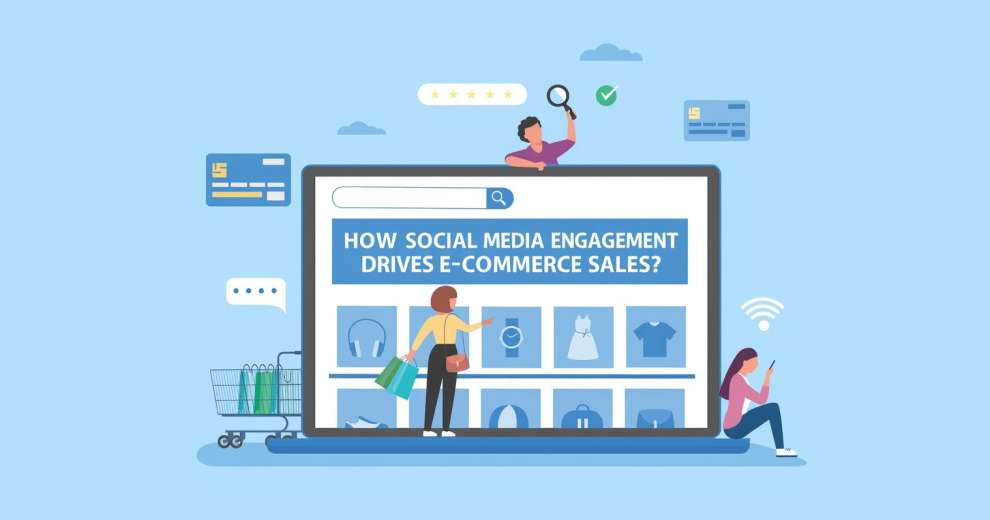E-commerce is built on a simple principle: “Click, pay, deliver—convenience is the new loyalty.” Today, it knows no boundaries and has reached millions across the globe. The old days of shopping directly from stores, watching movies only in cinema halls, or dining exclusively at hotels are long gone. Now, everything is available online at just a tap. For shopping, people have platforms like Amazon and Flipkart. For food, apps like Swiggy and Zomato are at their service. And for entertainment, streaming giants like Netflix and Prime have replaced traditional theaters.
E-commerce is now evolving into social commerce, where people are increasingly buying directly through social media platforms like Instagram and Facebook. Initially, these platforms were mainly used for finding friends and communication. However, this has changed over time. Today, social media not only connects people but also influences them to become buyers, turning casual browsing into instant shopping. A few years ago, people opened Instagram, Facebook, or YouTube just to scroll and interact. Now, those same platforms are turning into marketplaces where a simple “like” can lead to a “buy.”
E-commerce has changed the way we shop, but social media has taken it a step further. Platforms like Instagram, Facebook, WhatsApp, and YouTube are no longer just for connecting with friends—they’ve become powerful tools that help businesses reach, engage, and sell to customers.
The Shift from Social Media to Social Commerce
People often come to platforms like Instagram, YouTube, or Facebook simply to watch videos or scroll through their feeds. While doing so, they come across content from their favorite influencers showcasing the products or services they use. This creates a sense of trust and relatability, which strongly influences users to make similar purchases. A simple “like” on a post can quickly turn into curiosity, then desire, and finally a purchase decision.
This is how social media platforms have become powerful drivers of e-commerce—blurring the line between entertainment and shopping. Today, social commerce thrives on the idea that recommendations from influencers feel more genuine than traditional ads. In fact, many users no longer search for products directly; instead, they discover them while scrolling, making social media the new shopping mall of the digital age.
How a “Like” Becomes a “Buy”
The journey often begins when users casually scroll through their feeds. Along the way, they encounter posts, reels, or videos from their favorite influencers promoting products. This creates trust and relatability—two factors that significantly shape purchase decisions.
- A like sparks interest.
- Interest grows into curiosity.
- Curiosity leads to desire.
- Desire finally results in a purchase.
This is the essence of social commerce: the transition from passive engagement to active buying. Influencers and peer recommendations feel more authentic than traditional advertisements, making users more likely to act on them.
The Digital Push
Social media is playing a powerful role in pushing e-commerce by transforming casual browsing into instant buying. Platforms like Instagram, Facebook, and YouTube are no longer just for entertainment—they have become virtual marketplaces where influencers act as digital salespeople, promoting products in a relatable way that builds trust. Likes, comments, and reviews serve as modern word-of-mouth, influencing purchase decisions and giving consumers the confidence to shop. At the same time, advanced algorithms personalize ads based on user interests and behavior, ensuring that the right products reach the right audience. With features like “Shop Now” buttons, in-app checkout, and product tags, social media makes the shopping process seamless and convenient. This mix of discovery, trust, personalization, and accessibility shows how social media is not just supporting but actively driving the growth of e-commerce.
How Social Media Fuels E-Commerce
- Social media creates product awareness: Platforms like Instagram, Facebook, and YouTube help brands introduce new products to the market. Posts, reels, and short videos act as quick marketing tools that capture attention and make people aware of what’s new and trending.
- Engagement builds trust: Likes, comments, and reviews play a crucial role in influencing purchase decisions. Before buying, people often check feedback and interactions on posts to understand the product’s quality, popularity, and credibility. This peer validation works almost like digital word-of-mouth.
- Convenience of shopping: social media has made the buying process extremely simple and convenient. With features like “Shop Now” buttons, in-app checkout, and product tags, users can go from discovery to purchase without ever leaving the platform.
- Personalized marketing opportunities: Social media platforms use advanced algorithms to analyze user behavior, interests, and demographics. This allows sellers to deliver personalized ads and target the right audience, ensuring their products reach people who are most likely to buy them.
Together, these factors show how social media has transformed from being just a communication tool into a powerful driver of social commerce, where discovery, trust, and convenience converge to create seamless shopping experiences.
The rise of social commerce proves that shopping is no longer a separate activity—it has become part of our daily social interactions. A simple scroll can introduce new products, a like can spark curiosity, and an influencer’s recommendation can inspire trust that leads to a purchase. Social media has blurred the lines between entertainment, connection, and commerce, turning platforms like Instagram, Facebook, and YouTube into dynamic marketplaces.
For businesses, this shift opens up endless opportunities to reach the right audience, build relationships, and convert engagement into sales. For consumers, it offers unmatched convenience, personalization, and accessibility. In short, the journey from “like” to “buy” reflects the future of e-commerce, where social media is not just a platform—but the new shopping destination of the digital era.
– Shruti Kerur













